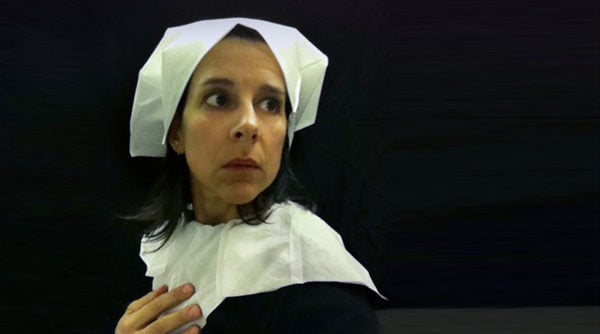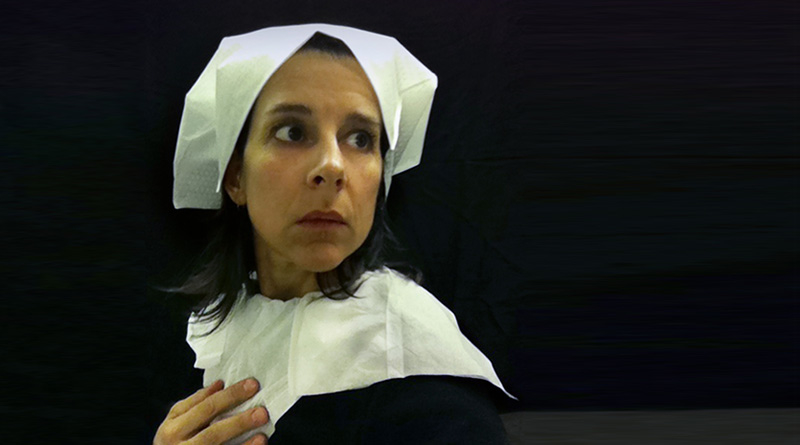
A popcorn machine with a microphone inside, TV monitors playing six channels simultaneously, a rearranged world map with the US neighboring the Middle East, pictures of pink hand-made spider webs — you may wonder what ties these seemingly random objects together. Multimedia artist Nina Katchadourian, creator of these works-of-art, explores diverse themes with unlimited possibilities of medium, and she takes you on board to her curious adventure.
Before you are able to read Katchadourian’s introduction of the installation or the curator’s notes, a popcorn machine already takes away your attention. It stands upright in the middle of the hall, as if suddenly displaced from an entertainment park. A microphone hangs inside the machine and records the sound of popcorn popping. Referring to Morse codes, Katchadourian transcribes the language of popcorn into written latin letters. Arguably for the first time in the history of civilization, popcorn’s language is documented and brought alive. Its first word, Katchadourian decides, should be casted into bronze, adding a dose of timeliness to the new discovery. What is that first word? WE.
Turn around and your second mission in the adventure of this exhibit is to create a mixtape of the music of New York. Hesitantly, you stare at some entangled magnetic tape strips, reorganized, stitched together, and stuck in a frame. You pick up the headphones in front of you. For thirty seconds, you listen to traditional Indian music; somehow, a scrap of Vietnamese pop is thrown in; then, abruptly, comes a joyous flavor of Latin American music flows in. You snap your fingers along with the rhythm, and some melodic jazz flows in out of nowhere. Before you begin to slowly move your body with the melancholy singing, Latin America’s rapid tunes cut in again, but are shortly interrupted by heavy metal and bumpy beats. Katchadourian physically encountered and collected these audiotape strips when roaming in the New York City. “Songs of the Islands: Concrete Music From New York” illustrates the city as a microcosmic entity that embodies the concept of globalism and the cultures of the world.
In the next series on the wall, you are taken away from the world, detached from the human experience and given the opportunity to be the creator of the world. Katchadourian divides a world map into fragments and intentionally misplaces them: the US, for example, is sandwiched between the Middle East and Eastern Europe. You may wonder if it says something about US’s changing global agenda. In her version of the US map, “Coastal Merger,” the two coasts converge on top of the Heartland, transforming the vast land of North America into a thin, long peninsula. It denotes her own frequent journeys between the coasts but also implies a politically misrepresented America, where the elitist mainstream often neglects the silent majority.
You take a break from the intense travel and follow Katchadourian back to her childhood hometown. Through a series of photos and a video, you interact with nature like never before. Between branches, a silky line on the spiderweb reflects a flash of sunlight, and you notice the disjunctions on this once perfect creation of nature. Unlike any by-passer, Katchadourian carefully sews the spiderwebs back together with pink threads, like a surgeon stitching a wound. But on the next day, she discovers the web’s owner has rejected her masterpiece and re-fixed the holes itself. As she documents these fascinating encounters, she invites you to join her questioning of human’s complex relation with the nature.
Enough exploration of the outside world, why not take a glimpse in the artist’s internal world? You sit down in front of the next set of videos. Katchadourian appears in the central monitor, staring at the audience in the eye, “Katchadourian? That’s an unusual name. What is it?” An aged woman appears on the right-hand-side monitor, “It’s Armenian.” Katchadourian is interviewing her parents as if she has never known them or herself. She asks them about the origin of their family name and the composition of their accent, while you learn that Katchadourian’s parents have each lived in different parts of the world — Turkey, Armenia, Finland, Beirut — before they finally settled in the US. Just when you become amused by their strange dialogue, the video takes a surprising twist — Katchadourian and her parents redo the same dialogue, imitating each others’ accents. While the artist attempts to mimic her foreign-born parents’ “heavy” English accents, her parents also struggle to pronounce in her “standard” American English. You move on with more questions: How much does accent matter in one’s identity? What does it mean to be an “American?” And how does linguistic diversity relate to Americanness?
Curiouser indeed, you begin to delve further into Katchadourian’s other intriguing muses: icons on supermarket products, titles on book covers, tissue papers in lavatories on airplanes, her brother’s and her childhood toys or random observations or objects found during a flight. In this adventure, you can find the most ordinary objects infused with the most bizarre ideas. Katchadourian’s childlike curiosity fills her daily life with inspirations; as she inserts meaning in the mundane, the artist further empowers the viewers to explore the ordinary with the same childlike curiosity.
Contemporary art can seem intimidating and confusing at times. A blank canvas, some nonsensical symbols or an absurd video is not only incomprehensible, but unrelatable. Katchadourian consciously steers away from the lofty and philosophical concepts and techniques; instead, she enables the viewers to find enjoyment and revelation from her ingenious imagination. Katchadourian’s “Curiouser” is indeed a powerful pursuit to demystify and substantiate the realm of contemporary art.
Stanford-born, New York-based artist Nina Katchadourian’s solo exhibition “Curiouser” is on display at the Cantor Arts Center through January 7, 2018.
Contact Zecheng Wang at zechengw ‘at’ stanford.edu.
